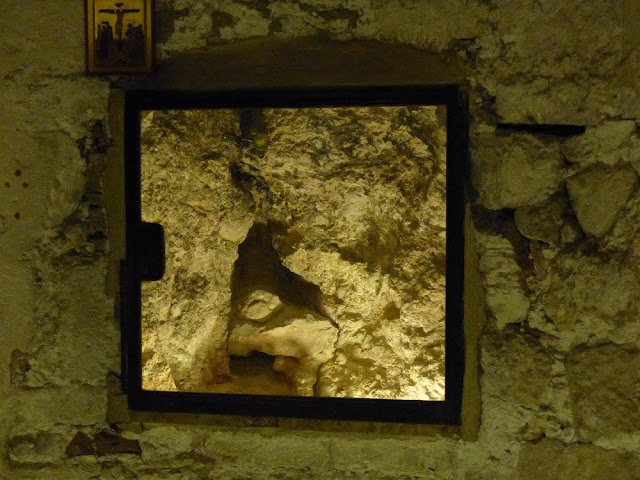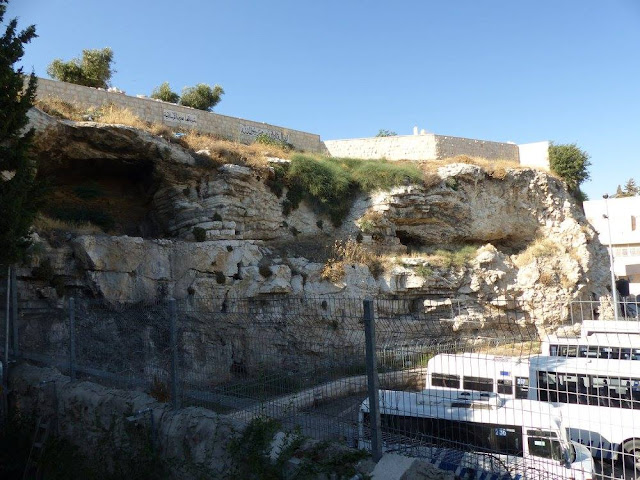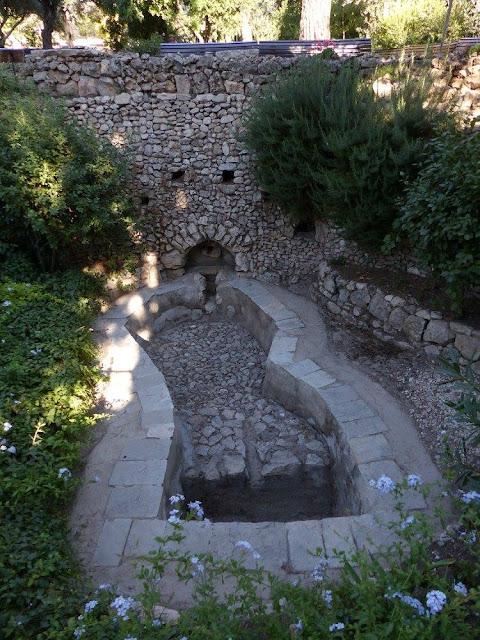Church of the Holy Sepulchre and the Garden Tomb
A few weeks before departing for my trip to Israel my father told me he was excited that I would be able to see the tomb where Jesus was buried. I responded I wasn't excited because the area where Jesus was actually buried was up for some dispute, after which our conversation moved on to another topic. In reality there are two religious tourist attractions in Jerusalem claiming to be the area where Jesus was buried, maintained by different sects of Christianity: the Church of the Holy Sepulchre and the Garden Tomb.
 |
| One of the stations of the Via Dolorosa (way of grief), more commonly known as the stations of the cross. Plaques likes this note the locations of the stations throughout old Jerusalem. |
Originally I did not plan on visiting either of these sites. Since it is unclear where the event actually happened why waste my time visiting two maybe kind possible sites? However, I now appreciate them for their cultural history (a lot of people have really cared about these tombs for a long time) and how their contrasting natures show how much religion really is up for interpretation.
 |
| The Via Dolorosa ends at the Church of the Holy Scepluctre shown above, built on the demolished hill thought to be Golgotha by some sects of Christianity. |
We visited the Church of the Holy Sepluchre first which is at the end of the Via Dolorosa (way of grief) also known as the stations of the cross. The Via Dolorosa consists of fourteen sites on the streets and in churches where specific things happened to Jesus, most of which are not actually mentioned in the Bible but came about hundreds of years later from oral history and church decrees. They include important events like Jesus falling while carrying the cross or wiping his face with a handkerchief which then took on magical powers, etc. The way of grief winds its way through the streets of Jerusalem from the Mount of Olives side to the Citadel of David side where the Church of the Holy Sepulchre was constructed. The Church of the Holy Sepulchre is a massive complex of relics, chapels, and other rooms built by Saint Helena.
 |
| The only parts of the hill that can still be seen today are encased in plexiglass inside the church. |
A few hundred years after Jesus' death countries started mandating Christianity as the state religion. Armenia was the first in the fourth century, followed soon after by the Roman Empire from decree of its emperor Constantine. Shortly after converting an entire empire to Christianity, Constantine sent his mother Helena to the Holy Land to preserve the important sites relating to Jesus' life and death. She built several churches while there, one on the Mount of Olives, one in Bethlehem, one in Nazareth, and Church of the Holy Sepulchre in Jerusalem.
 |
| Pilgrims can wait in line for the opportunity to reach through a hole in the plexiglass to touch the basement rock Jesus was supposedly crucified on. |
At the point in time when Helena visited Jerusalem looking for Jesus' tomb, it was over three hundred years after his death and probably six generations later. She went around the city asking locals where Jesus' tomb was. A small throng of people took her out the eastern side of the city pointed to a small rise and said that was Golgotha where he was crucified then they pointed to a hole in a hill a hundred feet away and said that's where he was buried. Then they proceeded to show her a whole bunch of other holy relics in the area such as a flat stone on which he was prepared for burial and a cave under the hill where supposedly Jesus' blood ripped onto Adam's (as in Adam and Eve's) skull, and so many more I cannot remember.
| Pilgrims behind me kiss and pray on a rock on which supposedly Jesus was prepared for burial. I didn't kiss it or pray on it, but I did touch it, just in case. |
Helena set to work building an entire complex to commemorate all of these holy sites which was partially destroyed, renovated, and added onto over the centuries. They pariatlly destroyed the hill of Golgotha in the construction process. So no real hill is evident from the outside. The hill which enclosed the tomb of Jesus has been whittled down so that only a thin veneer of the original rock is left in what looks like a decked out trailer. I felt eternally lost inside the series of buildings. It was a maze overcrowded with pilgrims from the sects of Christianity that hold this as the true site of Jesus' death and resurrection. Rocks held to be holy are touched and kissed constantly by massive crowds from all over the world.
| What is left of Jesus' tomb. Workers whittled down the rock around it, decorated it, and then built a dome around it. The wait to go in was about an hour when we visited. We skipped entering. |
| The line to enter the tomb of Jesus wraps almost all the way around the tomb. |
 |
| The place where supposedly Jesus' blood dripped down through the rock onto Adam's skull. The large crack in the rock is attributed to the earthquake that occurred when Jesus died. |
Reading through the list of churches involved in managing the church above, one large group of Christians is missing from the list: protestants. Protestants do not trust that Saint Helena was actually shown the correct area of Jesus' demise, especially since it was based on so many generations' word of mouth. Instead protestants used archeology to pick an area where they believe it is most likely Jesus was crucified and buried, now known as the Garden Tomb. Something different also about the Garden Tomb is that unlike at the Church of the Holy Sepulchre where long lines exist for people to touch and kiss relics known by certain sects of Christianity to be things that touched Jesus, the protestant emphasize it's not really important to know where Jesus was buried, and the Garden Tomb might not be that place. What is important to them is the message of Jesus' sacrifice for them.
 |
| Golgotha (skull hill) according to the protestants. The right eye caved in a few years ago, and a bus station has been built over the mouth. |
Why the protestants think the Garden Tomb is the place where Jesus died and was buried is a pretty impressive list of facts. The hill adjacent to the Garden Tomb, which they believe to be Golgotha (also known as skull hill) has some caverns in it that make it look like a skull. Unfortunately the mouth was paved over to make room for a bus station, but I could make out the likeness with just the eyes. The tomb and hill are outside the city (although on the western side, not the eastern side like Church of the Holy Sepulchre) at a major crossroads which is where Romans likes to crucify people. There is are structures which indicate the area was a vineyard in Roman times, including a cistern and wine press dated to the time of Jesus. Most importantly there is a complete and empty tomb dating to the Roman period. The list given to us at the Garden Tomb supporting that this is the tomb Jesus was buried in is a lot longer than what I list here. I can only remember a cliff notes version.
I really liked the Garden Tomb. It was quite and subdued, and actually in a garden. The peace and sunshine was welcome after the hectic, crowded, dark, and smokey (from all the candles) Church of the Holy Sepulchre. The volunteers from around the world at the Garden Tomb were friendly and welcoming. Of course I may have just felt that way because they were mostly from English-speaking countries. Which site is the correct one no one really knows. The protestants don't even really care. What is most important about these sites in reality is what they mean to people, and how important they are to the cultural heritage of Christians. For that, I am glad I visited both and learned a little bit more about Christianity.
 |
| A Roman wine press at the Garden Tomb dating back to the time of Jesus and indicating that this area was a garden during that time. |
I want to thank my goof friend Kyle for taking all of these awesome photos. Want to read more about my time in Jerusalem? Check out my post about the Kotel Tunnels and Rampart's Walk.

No comments:
Post a Comment